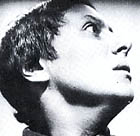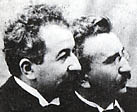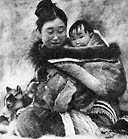Spotlight for Spring 2000:
Silent Giants
There are a handful of films that, upon their ending, I think, "That must
certainly be the best film ever made." Not a very critical statement, to be sure, but
one that nonetheless clues me in to the daunting genius of these films. It is at this
point that I am doomed to wrestle with these films’ greatness.
 One of the
masterpieces happens to be a silent film, The Passion of Joan of Arc, by Carl
Theodore Dryer. The claim of this film is to account the last days of Saint Joan, as it
follows the court transcripts of her infamous trial. Hence the films begins with this
trial, and ends with, well, her sentence carried out. Though this material may sound
banal, or at least limited in scope, in Dryer’s reverent hands the material
transforms and transcends both our expectations and understandings. That is, the film does
not so much tell a story as it does illuminate a psychological and spiritual world. And
how… One of the
masterpieces happens to be a silent film, The Passion of Joan of Arc, by Carl
Theodore Dryer. The claim of this film is to account the last days of Saint Joan, as it
follows the court transcripts of her infamous trial. Hence the films begins with this
trial, and ends with, well, her sentence carried out. Though this material may sound
banal, or at least limited in scope, in Dryer’s reverent hands the material
transforms and transcends both our expectations and understandings. That is, the film does
not so much tell a story as it does illuminate a psychological and spiritual world. And
how…
How does it manage this? I cannot but begin to speak of it. The film opens without any
kind of traditional "establishing shot." There is no distinct architectural
world to place action or characters. There we see Joan, and a panel of judges, almost
exclusively in close-up. We register their faces, their individualities, with scarce
enough time before the interrogation begins. Excuse me, I mean questioning.
And the judges tear into her, with insults, ridicule, and condescending questions. As
the camera investigates their faces, their expressions, we find them low and base, of
singular intent and contempt. The camera, though intensely displaying their human
features, transforms them into, or lets them show themselves as, hounds that have scented
prey.
For the viewer, there is no relief to be found in the headshots of Joan. We find her
staring off someplace, answering the questions posed haltingly yet with a painful honesty.
Where is she? Doesn’t she realize what is happening? Her eyes gaze off into infinity,
neither at her accusers nor into the camera. It is as if these matters, here in this
world, are no longer of great concern. She will implicate and indict herself, as long as
her faith remains untouched, unspoiled by these dirty men. Yet how can we "see"
faith, how can the film project these inner worlds?
Dryers’ camera explores these actors’ faces as though they are great
landscapes, beautiful and expressive of the conditions of thought. His close-ups bewilder
us with a paradox of human expression and unknown-ness. Joan seems to betray every thought
and emotion, yet the impetus for these inner workings is felt to be someplace else,
somewhere off in the infinity toward which she stares. We find her in ecstasy, subject to
some experience truly unknowable. In this way, through letting Joan’s face indicate
both what is there as well as implicate some knowledge which is distinctly elsewhere,
Dryer’s camera transcends our own visual understanding. We believe in her, if
not in what she believes.
But, to briefly be a little more concrete about the face as a landscape of expression
in this film, I think of one moment in particular. This is, as some question occurs to one
of the judges. (We see it by the look on his face). As he leans to whisper his idea to the
man next to him, the camera begins what I take as the best panning shot in cinematic
history. He whispers, the camera tacking his movement, registers the other judges
approval, and continues following as the next judge passes the whisper down the line. The
camera tracks the progress of the judges incrimination of Joan, follows the progress of
the question as it is silently whispered through each of them. And as each of their faces
resolves into smugness at her inevitable guilt, and their superiority, the camera condemns
them for their conspiracy and arrogance. (The only pans comparable to this that
spring to mind are Antonioni’s, of vacant, silent spaces).
And as to the fever-pitch conclusion to this film, how does one find the words?
The only person I know of as trying, and doing a good job of it, is Stanley Cavell. He
writes of the execution, "…When (Joan) at the stake looks up to see a flight of
birds wheel over her…They, there, are free. They are waiting in their freedom, to
accompany her soul. She knows it. But first there is this body to be gone through
utterly."
In beginning to think of this film, and in writing this beginning of a thought, I was
confronted with other silent masterpieces. I should say it takes no effort to acknowledge
these films, as great (silent) visual storytelling is one requirement for a great film.
That is, silent films lend themselves more easily to appreciation of what they
accomplished for the visual medium.
I take it that as film was first exploring how to do what it does, much experimentation
took place as to how. The silence of the movies put that much more emphasis on the power
of the images projected. Movies were forced to transcend, or at least circumvent, sound
altogether. And so we find some silent giants whose images will never be matched.
From its very birth, with the Lumiere brothers, film spoke straight through the eyes of the world
around us. The Lumieres’ works, though short in length and humble in scope,
nevertheless begin our history with the moving image. The world would never be the same. film spoke straight through the eyes of the world
around us. The Lumieres’ works, though short in length and humble in scope,
nevertheless begin our history with the moving image. The world would never be the same.
On the narrative end, one director of great silents is Fritz Lang, who made both Dr.
Mabuse and Metropolis, among many others. Metropolis in particular is a
hands-down perfect example of how  a
complex narrative can be constructed through visual means. Cutting from scene to scene,
from one action to another, the film displays a fully realized world of desperation and
revolution. The power of the singular image, and they are extraordinary, culminates into
an epic tale any director would be envious of. (Kubrick’s 2001:A Space Odyssey
manages a leaner type of epic. Though not strictly a silent film, its elemental visual
storytelling and lack of dialogue put in the same camp as these other films. That is, it
may as well be silent). a
complex narrative can be constructed through visual means. Cutting from scene to scene,
from one action to another, the film displays a fully realized world of desperation and
revolution. The power of the singular image, and they are extraordinary, culminates into
an epic tale any director would be envious of. (Kubrick’s 2001:A Space Odyssey
manages a leaner type of epic. Though not strictly a silent film, its elemental visual
storytelling and lack of dialogue put in the same camp as these other films. That is, it
may as well be silent).
One of the ways I engage films I like is to, during a viewing, take any particular shot
out of context, and weigh it on its’ own. I ask "What is this image? What does
it do all by itself?". All too often, individual shots become meaningless without the
preceding and following shots. Yet, in many silent films, I find a reveling and joy in the
compositions, in the shades of light, and the movement of an eyebrow. The directors
indulged in singular moments of poetry, at so many times turning the everyday into the
extraordinary.
Flaherty’s Nanook of the North springs to mind. Under the pretense of
observing the day to day life of an Eskimo man and
his family, the film meditates on life and beauty. Claiming to objectively record an
"uncivilized" people, we watch as the movie pauses on simple, gorgeous moments
of human interactions. These are no exotics, no, they are as anyone; and we can reflect on
our own hardships and joys by this sublime example, as well as their individuality. life of an Eskimo man and
his family, the film meditates on life and beauty. Claiming to objectively record an
"uncivilized" people, we watch as the movie pauses on simple, gorgeous moments
of human interactions. These are no exotics, no, they are as anyone; and we can reflect on
our own hardships and joys by this sublime example, as well as their individuality.
But all is not only serious or beautiful in the world of silent films. For the best in
comedy, ever, Chaplin and Keaton stand unrivaled. Both men both directed and starred in
their films, so many of them masterpieces. Keaton in particular discovered first and fully
the hilarity of letting the audience in on what the characters can’t see. That is, he
was a master of showing the unseen danger around the corner, allowing the audience in on
the dangers of the world he obliviously avoids.
Chaplin is found on the other end of expressiveness. He is the eternal clown, the
simple hobo, light-heartedly making the best out of any situation. His magic turns food
into shoes, and shoes into food. His every gesture speaks of hope and perseverance. At the
end of City Lights he silently speaks to us all with that ambiguously shifting
look.
These are but a few examples of great silent films, great films generally. Through
being forced to rely solely upon the power of their images, they explore thoroughly those
images in a way sound films are not compelled to. They establish the means by which films
make sense on a visual level, and so instruct us in what all movies are able to do.
This Spotlight was written by Daniel Herbert - ALPHAVILLE VIDEO's resident
expert on silent films.
Next spotlight: Restoring the
Classics |

